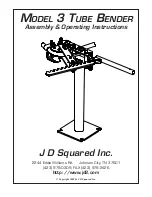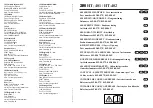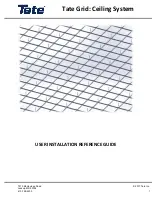
4
M30 11 / M30 17 SPIRIT EXPRESS M30500-A
(GB) ENGLISH
Climbing quickdraw
Inspection, points to verify
Before each use, make the following checks for
each carabiner; check the body and the rivet,
check that the gate closes correctly and that
the gate and keylock are correctly aligned. The
Keylock slot must not be blocked by foreign
materials (dirt, pebble, ice...).
Check the webbing and the safety stitching. Look
for cuts in the webbing, wear and damage due
to use, to heat, and to contact with chemical
products, etc... Be particularly careful to check
for cut threads.
Do not continue to use this product after a major
fall (for example a fall factor 1 with UIAA/CE
dynamic rope): even though no external signs
may be visible, internal damage may have
occurred, thus reducing its strength and its
margin of safety. Severe falls can deform the
webbing, disrupting its structure. Repeated short
falls can also cause deformations, which lead to
the same result, gradually reducing the strength
of a sling until it is no longer safe to use. Contact
PETZL in case of any doubt.
Instructions for use
Diagram 1. Installation
Clip the rope correctly. The rope from below must
pass behind the carabiner, through it, then out
toward the climber. A twist in the sling can lead
to self-unclipping of one of the two carabiners (at
the anchor point or the rope). The carabiner gate
must be positioned opposite to the direction of
movement of the climber.
Diagram 2. Falling
When a fall occurs, the rope moves quickly,
suddenly, and unpredictably, sometimes forming
a loop above the carabiner. This «whiplash»
movement can cause the rope to come out of the
carabiner. A carabiner with a bent gate increases
the risk of unclipping.
Diagram 3. Precautions
When closed, the carabiner is strongest when
loaded along the long axis; loading in any other
direction reduces the strength.
The strength of a carabiner is greatly reduced if
the gate is open at the moment of impact:
- opening caused by an impact against the rock,
- the surface of the rock pushes the gate open ,
- the rope running through the carabiner can set
up vibrations capable of opening the gate.
Nothing must obstruct the carabiner; an y
obstruction or loading over an edge reduces its
strength.
Instructions for use
(FR) FRANCAIS
Dégaine d’escalade
Contrôle, points à vérifi er
Vérifi er avant toute utilisation pour chaque
mousqueton, le corps, le rivet, le bon
fonctionnement de fermeture du doigt et le bon
alignement doigt, keylock. Le trou du Keylock ne
doit pas être encombré (terre, caillou…).
Vérifi er les sangles et les coutures de sécurité.
Surveiller les coupures, usures et dommages dus
à l’utilisation, à la chaleur, aux produits chimiques
etc... Attention aux fi ls coupés.
Après une chute importante (par exemple facteur
de chute 1 avec une corde dynamique CE UIAA),
ce produit ne doit plus être utilisé. Des ruptures
internes non apparentes peuvent entraîner
une diminution de sa résistance limitant son
fonctionnement.
Les chutes importantes déforment les sangles,
désorganisent leur structure. Les répétitions
de petites chutes provoquent aussi des
déformations qui aboutissent au même résultat et
réduisent graduellement la résistance de l’anneau
jusqu’au moment où il n’assurera plus votre
sécurité. Contacter PETZL en cas de doute.
Prescriptions d’utilisation
Schéma 1. Mise en place
Mousquetonner la corde correctement. La corde
dans le mousqueton doit passer de la paroi vers
l’extérieur. Attention le vrillage de la dégaine peut
entrainer l’auto-décrochage de l’un des deux
mousquetons (au niveau de l’ancrage ou de la
corde). Le doigt du mousqueton doit être placé
à l’opposé de la direction de progression du
grimpeur.
Schéma 2. Chute
Lors d’une chute, le mouvement brutal et rapide
de la corde est incontrôlable. Un déplacement
de la corde en coup de fouet peut même, dans
certains cas, faire sortir la corde du mousqueton.
Un mousqueton à doigt coudé augmente le
risque de décrochage.
Schéma 3. Précautions
Fermé, le mousqueton offre la résistance
maximum dans le sens de la longueur, toute
autre position réduit sa résistance.
La résistance d’un mousqueton diminue si par
accident, le doigt s’ouvre à l’instant du choc :
- ouverture provoquée par un choc contre le
rocher,
- le relief du rocher repousse le doigt du
mousqueton,
- la corde coulissant dans le mousqueton,
peut créer des vibrations capables d’entraîner
l’ouverture du doigt.
Rien ne doit gêner le mousqueton, toute
contrainte ou appui extérieur réduit sa résistance.
Prescriptions d’utilisation
(DE) DEUTSCH
Express-Schlinge zum Klettern
Kontrolle, zu prüfende Punkte
Vor jedem Gebrauch Körper, Niete sowie das
einwandfreie Einrasten des Keylocksystems des
Schnappers prüfen. Die Öffnung des Keylock darf
nicht verstopft sein (Schmutz, Steinchen...).
Vor jeder Benutzung müssen die Schlingen und
die Sicherheitsnähte geprüft werden. Achten Sie
auf Schnitte, Abnutzungsspuren und sonstige
Schäden,die durch Gebrauch,Hitze, chemische
Produkte oder sonstige Einwirkungen entstanden
sein könnten. Achtung bei zerschnittenen Fäden.
Großer Sturz: Nach einem großen Sturz (z.B.
Faktor 1 mit UIAA dynamischem Seil) darf dieses
Produkt nicht mehr benutzt werden. Innere,
nicht erkennbare Risse können seine Festigkeit
und Funktion vermindern. Scheuen Sie sich
nicht, im Falle eines Zweifels, Kontakt mit PETZL
aufzunehmen.
Gebrauchsanweisung
Darstellung 1. Einlegen des Seils
Um ein Verdrehen der Schlinge und ein
ungewolltes Aushängen zu vermeiden muß das
Seil richtig eingehängt werden: das Seil muß von
unten nach oben einlaufen und der Schnapper
muß immer entgegen der Fortbewegungsrichtung
sein. Dies ist dank der richtigen Handhabung mit
einer Hand möglich.
Darstellung 2. Sturz ins Seil
Bei einem Sturz sind die harten und schnellen
Bewegungen des Seiles unbeherrschbar. Ein
Peitschenschlag des Seiles kann in gewissen
Fällen zum Aushängen des Seiles führen. Diese
Gefahr des Aushängens ist bei den Karabinern
mit gebogenem Schnapper erhöht.
Darstellung 3. Vorsichtsmaßnahmen
Geschlossen bietet der Karabiner in
Längsrichtung seine maximale Festigkeit. Jede
andere Zugrichtung vermindert diese Festigkeit.
Die Festigkeit des Karabiners verringert sich
entscheidend falls sich, im Moment des
Fangstoßes, der Schnapper öffnet:
- Öffnen hervorgerufen durch Schlagen gegen
den Fels,
- eine Unebenheit im Fels öffnet den Schnapper,
- die Vibrationen im schnell gleitendem Seil,
können sich auf den Karabiner übertragen und
zum Öffnen des Schnappers führen.
Gebrauchsanweisung























